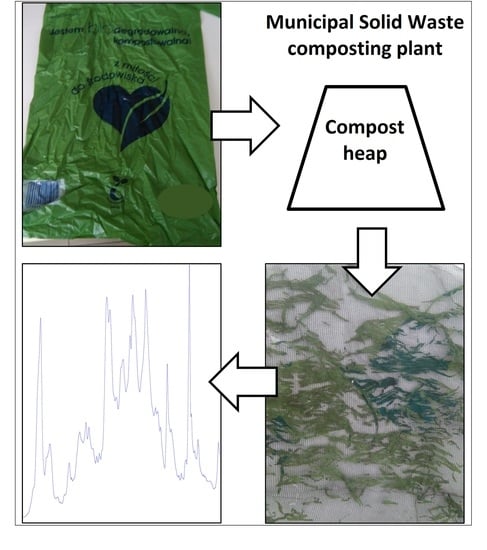Assessment of the Decomposition of Oxo- and Biodegradable Packaging Using FTIR Spectroscopy
Abstract
:1. Introduction
2. Materials and Methods
3. Results
4. Discussion
5. Conclusions
- As a result of the research, only some of the composted samples decomposed. In the remaining samples, only slight traces of degradation were visible, despite the fact that all the bags selected for the tests were to undergo oxo- and biodegradation.
- FTIR spectroscopy is a method that can be used to confirm the degradation of biodegradable and oxo-biodegradable materials; however, the results obtained in this way may not give unequivocal information about the degree of actual degradation of a given material. It may, however, help in detecting similarities in the structure of the analysed plastics.
- The analysis of spectra obtained with the use of FTIR spectroscopy indicated the presence of compounds in the tested samples that may be a potential source of compost contamination. Apart from the observation of the compounds proving the degradation of the material (oxygen groups, changes in C–H bonds), groups of alkyl halides were detected.
- Alkyl halide groups were found in most of the samples that were not decomposed in the composting process. These were the following samples: oxo-biodegradable (4, 7, 8, 10, 12) and biodegradable (6).
- The analysis of the spectra of the samples subjected to irradiation with UV rays and non-irradiated ones shows that there are no clear differences between the spectra of the irradiated and non-irradiated samples.
- Plastics with certificates confirming their biodegradability and compostability should be completely biodegradable in real conditions (e.g., during composting). Each component used in their production should be similarly tested, i.e., the dyes used should be completely biodegradable and safe for the environment. An example is the intensely coloured biodegradable sample no. 3, the decomposition of which was difficult, and metals such as copper, zinc and chromium could have entered the environment along with the compost.
Supplementary Materials
Author Contributions
Funding
Institutional Review Board Statement
Informed Consent Statement
Data Availability Statement
Conflicts of Interest
References
- Geyer, R.; Jambeck, J.R.; Law, K.L. Production, use, and fate of all plastics ever made. Sci. Adv. 2017, 3, e1700782. [Google Scholar] [CrossRef] [PubMed] [Green Version]
- Van Eygen, E.; Laner, D.; Fellner, J. Circular economy of plastic packaging: Current practice and perspectives in Austria. Waste Manag. 2018, 72, 55–64. [Google Scholar] [CrossRef] [PubMed]
- Rujnić-Sokele, M.; Pilipović, A. Challenges and opportunities of biodegradable plastics: A mini review. Waste Manag. Res. 2017, 35, 132–140. [Google Scholar] [CrossRef] [PubMed]
- Contat-Rodrigo, L. Thermal characterization of the oxo-degradation of polypropylene containing a pro-oxidant/pro-degradant additive. Polym. Degrad. Stab. 2013, 98, 2117–2124. [Google Scholar] [CrossRef]
- Gewert, B.; Plassmann, M.M.; MacLeod, M. Pathways for degradation of plastic polymers floating in the marine environment. Environ. Sci. Process. Impacts 2015, 17, 1513–1521. [Google Scholar] [CrossRef] [PubMed] [Green Version]
- Chinaglia, S.; Tosin, M.; Degli-Innocenti, F. Biodegradation rate of biodegradable plastics at molecular level. Polym. Degrad. Stab. 2018, 147, 237–244. [Google Scholar] [CrossRef]
- Agboola, O.; Sadiku, R.; Mokrani, T.; Amer, I.; Imoru, O. Polyolefins and the environment. In Polyolefin Fibres: Structure, Properties and Industrial Applications, 2nd ed.; Ugbolue, S.C.O., Ed.; The Textile Institute Book Series; Woodhead Publishing: Cambridge, UK, 2017; pp. 89–133. [Google Scholar]
- biodeg.org. Available online: https://www.biodeg.org/opa-briefing-note-3/ (accessed on 29 January 2021).
- epi-global.com. Available online: https://epi-global.com/tdpa-oxo-biodegradable/how-tdpa-works/ (accessed on 29 January 2021).
- tuv-at.be. Available online: https://www.tuv-at.be/green-marks/certifications/ (accessed on 29 January 2021).
- Eubeler, J.P.; Zok, S.; Bernhard, M.; Knepper, T.P. Environmental biodegradation of synthetic polymers I. Test methodologies and procedures. TrAC Trends Anal. Chem. 2009, 28, 1057–1072. [Google Scholar] [CrossRef]
- Ruggero, F.; Gori, R.; Lubello, C. Methodologies to assess biodegradation of bioplastics during aerobic composting and anaerobic digestion: A review. Waste Manag. Res. 2019, 37, 959–975. [Google Scholar] [CrossRef] [Green Version]
- Harrison, J.P.; Boardman, C.; O’Callaghan, K.; Delort, A.-M.; Song, J. Biodegradability standards for carrier bags and plastic films in aquatic environments: A critical review. R. Soc. Open Sci. 2018, 5, 171792. [Google Scholar] [CrossRef] [Green Version]
- Poonam, K.; Rajababu, V.; Yogeshwari, J.; Patel, H. Diversity of plastic degrading microorganisms and their appraisal on biodegradable plastic. Appl. Ecol. Environ. Res. 2013, 11, 441–449. [Google Scholar] [CrossRef]
- Giacomucci, L.; Raddadi, N.; Soccio, M.; Lotti, N.; Fava, F. Polyvinyl chloride biodegradation by Pseudomonas citronellolis and Bacillus flexus. New Biotechnol. 2019, 52, 35–41. [Google Scholar] [CrossRef]
- Eubeler, J.P.; Bernhard, M.; Knepper, T.P. Environmental biodegradation of synthetic polymers II. Biodegradation of different polymer groups. TrAC Trends Anal. Chem. 2010, 29, 84–100. [Google Scholar] [CrossRef]
- Viera, J.S.C.; Marques, M.R.C.; Nazareth, M.C.; Jimenez, P.C.; Sanz-Lázaro, C.; Castro, I.I.B. Are biodegradable plastics an environmental rip off? J. Hazard. Mater. 2021, 416, 125957. [Google Scholar] [CrossRef]
- Reddy, M.M.; Deighton, M.; Gupta, R.K.; Bhattacharya, S.N.; Parthasarathy, R. Biodegradation of oxo-biodegradable polyethylene. J. Appl. Polym. Sci. 2009, 111, 1426–1432. [Google Scholar] [CrossRef]
- Yang, Y.; Yang, J.; Wu, W.-M.; Zhao, J.; Song, Y.; Gao, L.; Yang, R.; Jiang, L. Biodegradation and Mineralization of Polystyrene by Plastic-Eating Mealworms: Part 1. Chemical and Physical Characterization and Isotopic Tests. Environ. Sci. Technol. 2015, 49, 12080–12086. [Google Scholar] [CrossRef]
- Wang, J.; Peng, J.; Tan, Z.; Gao, Y.; Zhan, Z.; Chen, Q.; Cai, L. Microplastics in the surface sediments from the Beijiang River littoral zone: Composition, abundance, surface textures and interaction with heavy metals. Chemosphere 2017, 171, 248–258. [Google Scholar] [CrossRef]
- Nawong, C.; Umsakul, K.; Sermwittayawong, N. Rubber gloves biodegradation by a consortium, mixed culture and pure culture isolated from soil samples. Braz. J. Microbiol. 2018, 49, 481–488. [Google Scholar] [CrossRef]
- Ruggero, F.; Carretti, E.; Gori, R.; Lotti, T.; Lubello, C. Monitoring of degradation of starch-based biopolymer film under different composting conditions, using TGA, FTIR and SEM analysis. Chemosphere 2020, 246, 125770. [Google Scholar] [CrossRef]
- Sánchez-Monedero, M.A.; Cegarra, J.; García, D.; Roig, A. Chemical and structural evolution of humic acids during organic waste composting. Biogeochemistry 2002, 13, 361–371. [Google Scholar] [CrossRef]
- Castaldi, P.; Alberti, G.; Merella, R.; Melis, P. Study of the organic matter evolution during municipal solid waste composting aimed at identifying suitable parameters for the evaluation of compost maturity. Waste Manag. 2005, 25, 209–213. [Google Scholar] [CrossRef]
- Smidt, E.; Meissl, K. The applicability of Fourier transform infrared (FT-IR) spectroscopy in waste management. Waste Manag. 2007, 27, 268–276. [Google Scholar] [CrossRef]
- Jung, M.R.; Horgen, F.D.; Orski, S.V.; C., V.R.; Beers, K.L.; Balazs, G.H.; Jones, T.T.; Work, T.; Brignac, K.C.; Royer, S.-J.; et al. Validation of ATR FT-IR to identify polymers of plastic marine debris, including those ingested by marine organisms. Mar. Pollut. Bull. 2018, 127, 704–716. [Google Scholar] [CrossRef]
- Demestre, M.; Masó, M.; Fortuño, J.M.; De Juan, S. Microfouling communities from pelagic and benthic marine plastic debris sampled across Mediterranean coastal waters. Sci. Mar. 2016, 80, 117–127. [Google Scholar] [CrossRef] [Green Version]
- Da Luz, J.M.R.; Paes, S.A.; Nunes, M.D.; Silva, M.D.C.S.D.; Kasuya, M.C.M. Degradation of Oxo-Biodegradable Plastic by Pleurotus ostreatus. PLoS ONE 2013, 8, e69386. [Google Scholar] [CrossRef] [Green Version]
- Barbes, L.; Radulescu, C.; Stihi, C. ATR-FTIR spectrometry characterization of polymeric materials. Rom. Rep. Phys. 2014, 66, 765–777. [Google Scholar]
- Hou, L.; Xi, J.; Chen, X.; Li, X.; Ma, W.; Lu, J.; Xu, J.; Lin, Y.B. Biodegradability and ecological impacts of polyethylene-based mulching film at agricultural environment. J. Hazard. Mater. 2019, 378, 120774. [Google Scholar] [CrossRef]
- Markowicz, F.; Król, G.; Szymańska-Pulikowska, A. Biodegradable Package-Innovative Purpose or Source of the Problem. J. Ecol. Eng. 2019, 20, 228–237. [Google Scholar] [CrossRef]
- Kumanayaka, T.O.; Parthasarathy, R.; Jollands, M. Accelerating effect of montmorillonite on oxidative degradationof polyethylene nanocomposites. Polym. Degrad. Stabil. 2010, 95, 672–676. [Google Scholar] [CrossRef]
- Mongi, C.E.; Langi, Y.A.R.; Montolalu, C.E.J.C.; Nainggolan, N. Comparison of hierarchical clustering methods (case study: Data on poverty influence in North Sulawesi). In IOP Conference Series: Materials Science and Engineering, Proceedings of the 3rd Indonesian Operations Research Association-International Conference on Operations Research, Manado, Indonesia, 20–21 September 2018; IOP Publishing Ltd.: Bristol, UK, 2019; p. 012048. [Google Scholar]
- Majerová, I.; Nevima, J. The measurement of human development using the Ward method of cluster analysis. J. Int. Stud. 2017, 10, 239–257. [Google Scholar] [CrossRef] [Green Version]
- Eszergár-Kiss, D.; Caesar, B. Definition of user groups applying Ward’s method. Transp. Res. Procedia 2017, 22, 25–34. [Google Scholar] [CrossRef]
- Markowicz, F.; Szymańska-Pulikowska, A. Analysis of the possibility of environmental pollution by composted biodegradable and oxo-biodegradable plastics. Geosciences 2019, 9, 460. [Google Scholar] [CrossRef] [Green Version]
- Malinowski, R.; Moraczewski, K.; Raszkowska-Kaczor, A. Studies on the Uncrosslinked Fraction of PLA/PBAT Blends Modified by Electron Radiation. Materials 2020, 13, 1068. [Google Scholar] [CrossRef] [PubMed]
- Vuković-Kwiatkowska, I.; Kaczmarek, H.; Dzwonkowski, J. Innovative composites of poly(lactic) acid for the production of packaging foils. Chemik 2014, 68, 135–140. [Google Scholar]
- Organic Chemistry. Available online: https://orgchemboulder.com/ (accessed on 3 October 2020).
- Chemistry LibreTexts. Available online: https://chem.libretexts.org/ (accessed on 3 October 2020).
- Shanmugam, K.; Doosthosseini, H.; Varanasi, S.; Garnier, G.; Batchelor, W. Nanocellulose films as air and water vapour barriers: A recyclable and biodegradable alternative to polyolefin packaging. Sustain. Mater. Technol. 2019, 22, e00115. [Google Scholar] [CrossRef]
- Sibeko, M.A.; Luyt, A.S. Preparation and characterisation of vinylsilane crosslinked low-density polyethylene composites filled with nano clays. Polym. Bull. 2014, 71, 637–657. [Google Scholar] [CrossRef]
- Benitez, A.; Sánchez, J.J.; Arnal, M.L.; Müller, A.J.; Rodriguez, O.; Morales, G. Abiotic degradation of LDPE and LLDPE formulated with a pro-oxidant additive. Polym. Degrad. Stabil. 2013, 98, 490–501. [Google Scholar] [CrossRef]
- Corti, A.; Sudhakar, M.; Chiellini, E. Assessment of the Whole Environmental Degradation of Oxo-Biodegradable Linear Low Density Polyethylene (LLDPE) Films Designed for Mulching Applications. J. Polym. Environ. 2012, 20, 1007–1018. [Google Scholar] [CrossRef]
- Bromine-Containing Dyes Dwarf Flame Retardants in House Dust. Chemical & Engineering News. Available online: https://cen.acs.org/articles/94/web/2016/11/Bromine-containing-dyes-dwarf-flame.html (accessed on 16 November 2020).
- Peng, B.-Y.; Chen, Z.; Chen, J.; Yu, H.; Zhou, X.; Criddle, C.S.; Wu, W.-M.; Zhang, Y. Biodegradation of Polyvinyl Chloride (PVC) in Tenebrio molitor (Coleoptera: Tenebrionidae) larvae. Environ. Int. 2020, 145, 106106. [Google Scholar] [CrossRef]
- Jacquin, J.; Cheng, J.; Odobel, C.; Pandin, C.; Conan, P.; Pujo-Pay, M.; Ghiglione, J.F. Microbial ecotoxicology of marine plastic debris: A review on colonization and biodegradation by the “Plastisphere”. Front. Microbiol. 2019, 10, 865. [Google Scholar] [CrossRef] [Green Version]
- Sheik, S.; Chandrashekar, K.R.; Swaroop, K.; Somashekarappa, H.M. Biodegradation of gamma irradiated low density polyethylene and polypropylene by endophytic fungi. Int. Biodeter. Biodegr. 2015, 105, 21–29. [Google Scholar] [CrossRef]
- Rouillon, C.; Bussiere, P.O.; Desnoux, E.; Collin, S.; Vial, C.; Therias, S.; Gardette, J.L. Is carbonyl index a quantitative probe to monitor polypropylene photodegradation? Polym. Degrad. Stabil. 2016, 128, 200–208. [Google Scholar] [CrossRef]
- Weithmann, N.; Möller, J.N.; Löder, M.G.J.; Piehl, S.; Laforsch, C.; Freitag, R. Organic fertilizer as a vehicle for the entry of microplastic into the environment. Sci. Adv. 2018, 4, eaap8060. [Google Scholar] [CrossRef] [Green Version]
- Al-Salem, S.; Al-Hazza’A, A.; Karam, H.; Al-Wadi, M.; Al-Dhafeeri, A.; Al-Rowaih, A. Insights into the evaluation of the abiotic and biotic degradation rate of commercial pro-oxidant filled polyethylene (PE) thin films. J. Environ. Manag. 2019, 250, 109475. [Google Scholar] [CrossRef]
- Gupta, K.K.; Devi, D. Characteristics investigation on biofilm formation and biodegradation activities of Pseudomonas aeruginosa strain ISJ14 colonizing low density polyethylene (LDPE) surface. Heliyon 2020, 6, e04398. [Google Scholar] [CrossRef]
- Shruti, V.; Kutralam-Muniasamy, G. Bioplastics: Missing link in the era of Microplastics. Sci. Total Environ. 2019, 697, 134139. [Google Scholar] [CrossRef]
- De Oliveira, T.A.; Barbosa, R.; Mesquita, A.B.; Ferreira, J.H.; de Carvalho, L.H.; Alves, T.S. Fungal degradation of reprocessed PP/PBAT/thermoplastic starch blends. J. Mater. Res. Technol. 2020, 9, 2338–2349. [Google Scholar] [CrossRef]
- Rummel, C.D.; Jahnke, A.; Gorokhova, E.; Kühnel, D.; Schmitt-Jansen, M. Impacts of biofilm formation on the fate and potential effects of microplastic in the aquatic environment. Environ. Sci. Tech. Let. 2017, 4, 258–267. [Google Scholar] [CrossRef] [Green Version]
- Guo, J.-J.; Huang, X.-P.; Xiang, L.; Wang, Y.-Z.; Li, Y.-W.; Li, H.; Cai, Q.-Y.; Mo, C.-H.; Wong, M.-H. Source, migration and toxicology of microplastics in soil. Environ. Int. 2020, 137, 105263. [Google Scholar] [CrossRef]
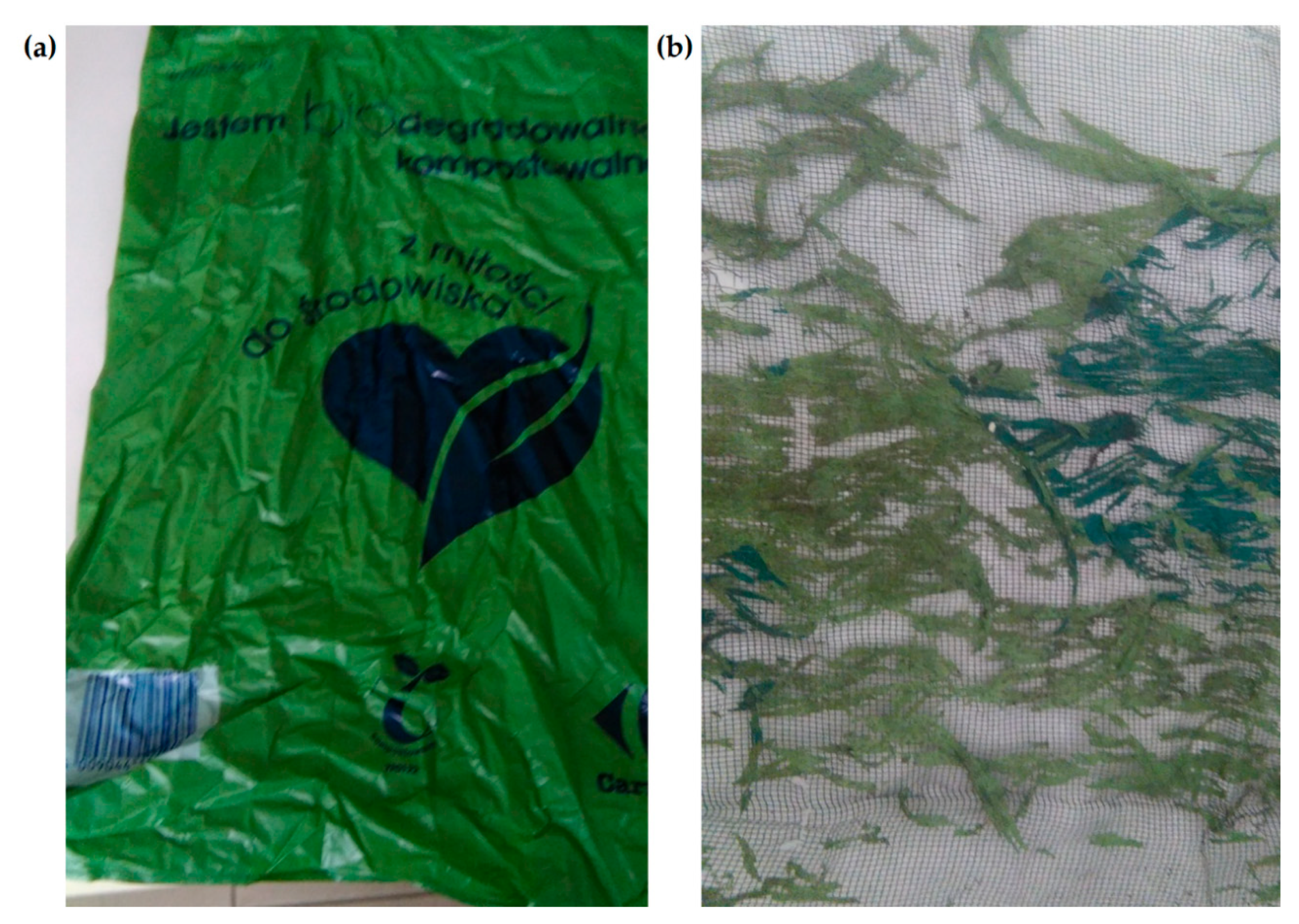
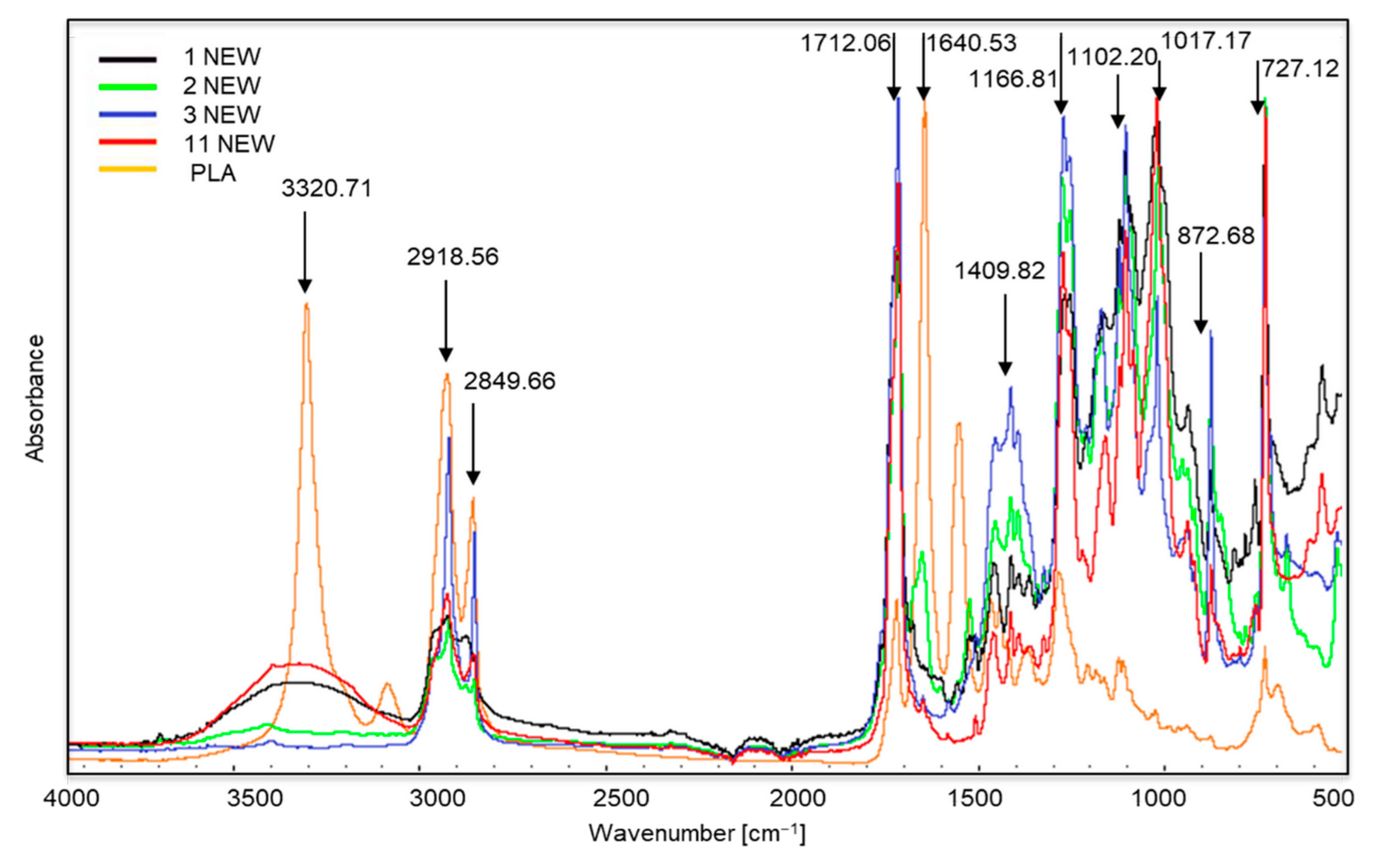
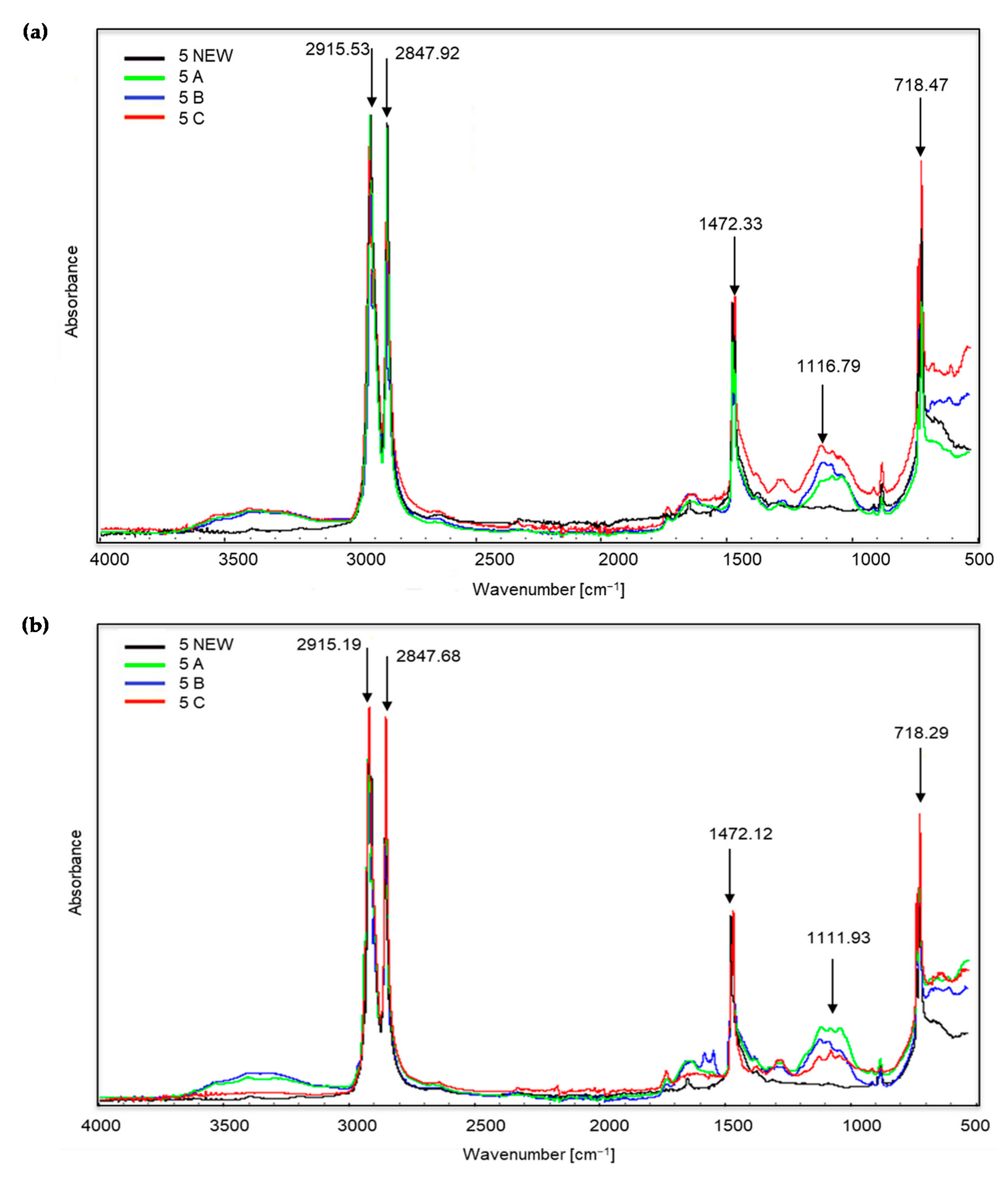
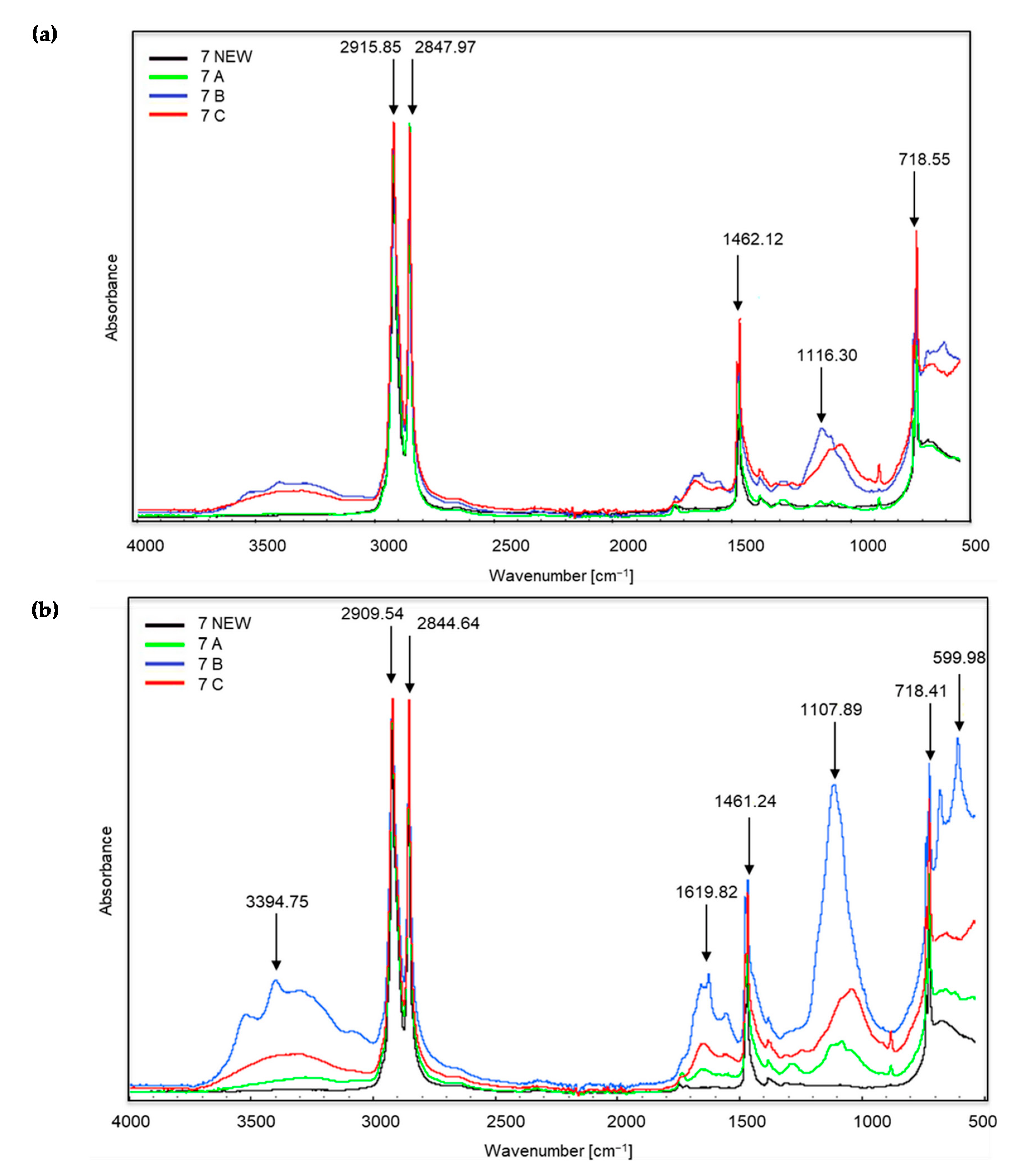
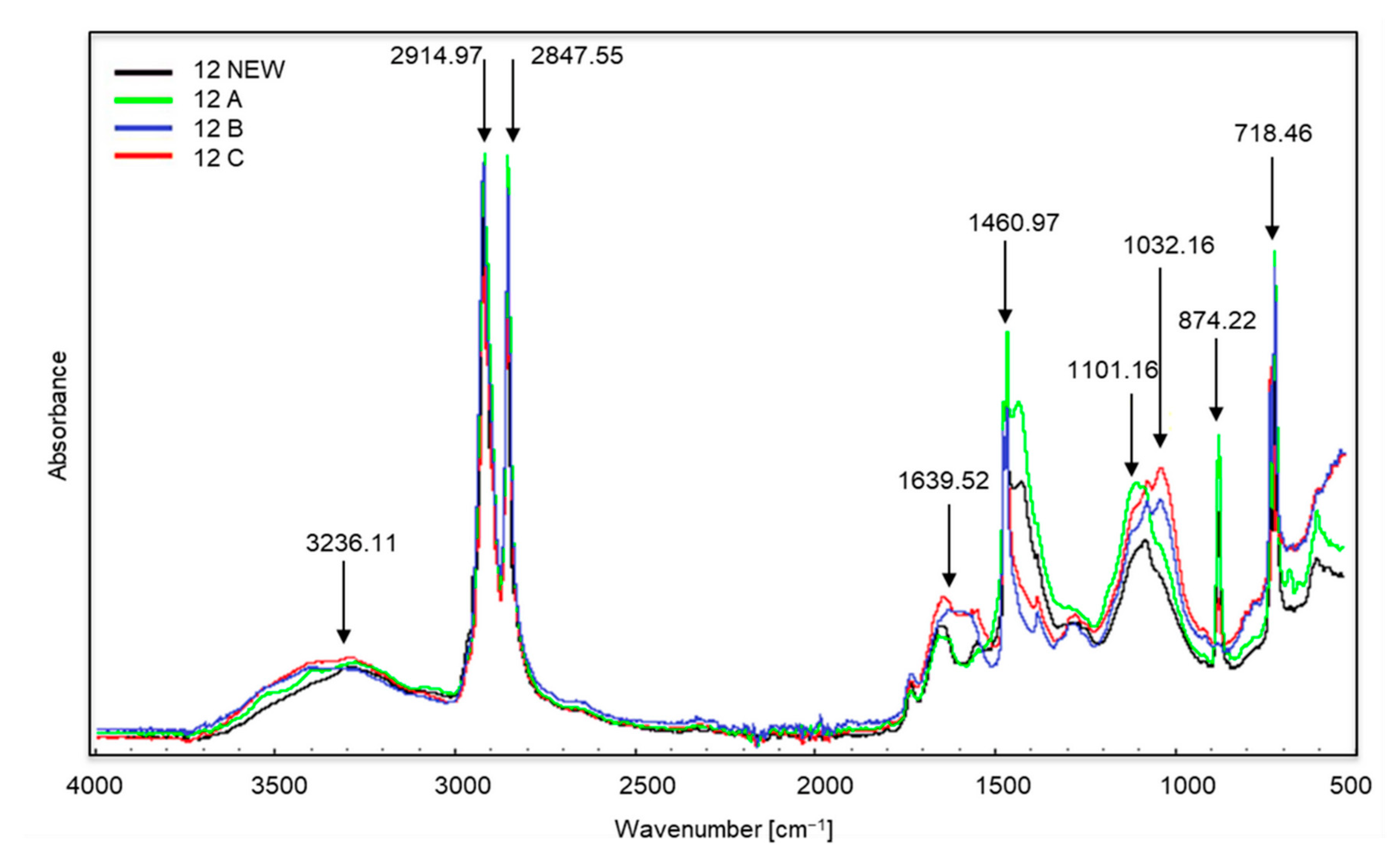
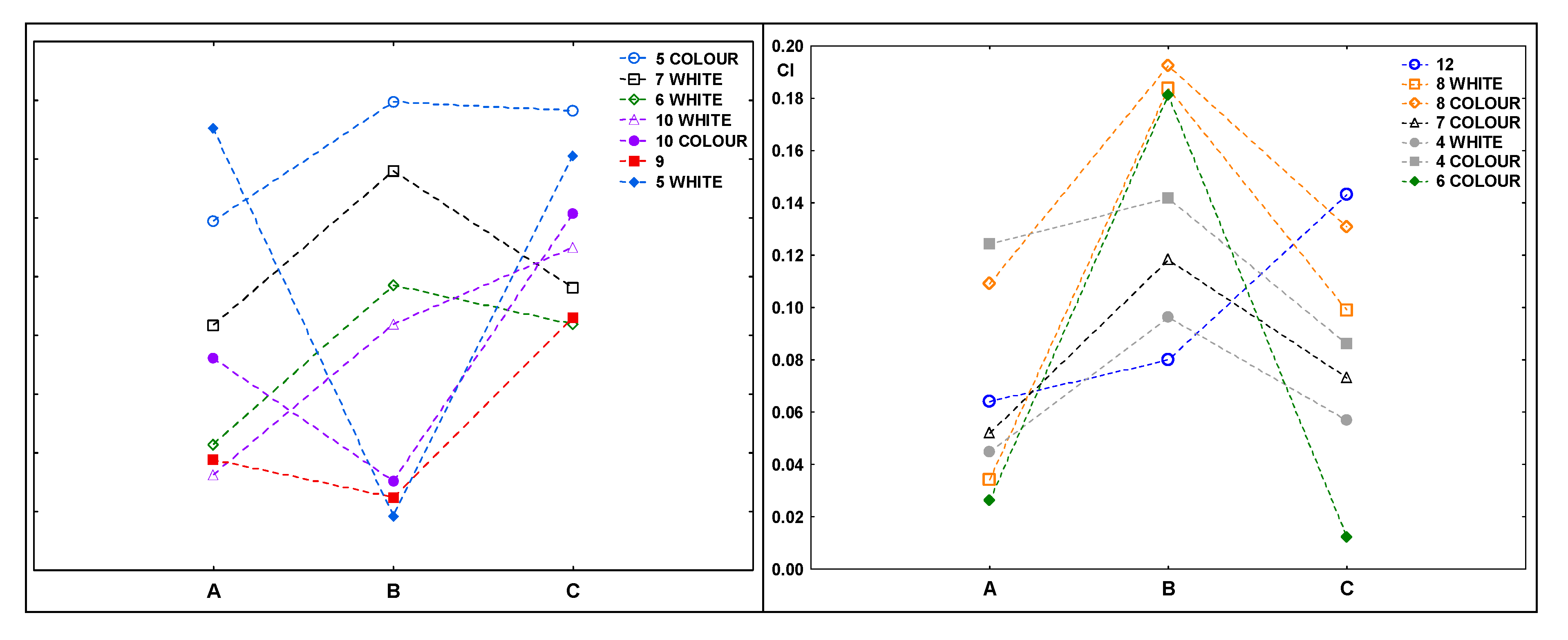
| Sample Number | Type of Polymer | Additional Manufacturer Information |
|---|---|---|
| 1 | Biodegradable, compostable | There is no need to remove from the stream of bio-waste at the composting industry |
| 2 | Biodegradable, compostable | It is degraded in composting conditions |
| 3 | Biodegradable, compostable | Made on the basis of corn and potato starch |
| 4 | Oxo-biodegradable, d2w® additive | It is decomposed under the influence of oxygen, UV and heat, use within 18 months |
| 5 | Oxo-biodegradable, TDPA additive | It is subject to accelerated decomposition |
| 6 | Biodegradable, LDPE and sugar cane | Sugar cane content above 85% |
| 7 | Oxo-biodegradable, d2w® additive | The bag is 100% biodegradable |
| 8 | Oxo-biodegradable, HDPE | The bag is oxo-biodegradable by 100% |
| 9 | Oxo-biodegradable, d2w® additive | It has the Oxo-biodegradable Plastics Association mark |
| 10 | Oxo-biodegradable, HDPE | The bag is oxo-biodegradable by 100% |
| 11 | Biodegradable, compostable | Bags for biodegradable waste |
| 12 | Oxo-biodegradable, HDPE | Bags for organic waste |
| Sample Number | Wave Number (cm−1) | |||
|---|---|---|---|---|
| >3001 | 2001–3000 | 1001–2000 | 500–1000 | |
| 4 | ~3289.77 and 3298.11 (C=C double bonds) | ~2915 and 2848 (stretching vibrations of the methylene C–H group) | ~1618–1625 (deformation vibrations of the amino group N–H), ~1471 and 1461 (C–H bending vibrations), ~1320–1000 (C–O oxygen groups in carboxylic and ester bonds) | ~874, 730 and 718 (C–Cl stretching vibrations of alkyl halides) |
| 5 | ~2915 and 2847 (stretching vibrations of the C–H methylene group) | ~1472 (C–H bending vibrations), ~1116 and 1111 (oxygen groups C–O in carboxylic and ester bonds) | ~874, 730 and 718 (C–Cl stretching vibrations of alkyl halides) | |
| 6 | ~2915 and 2847 (stretching vibrations of the C–H methylene group) | ~1651 (stretching vibrations of the C=C bonds), ~1525 (N–O nitro compounds), ~1461 and 1472 (C–H bending vibrations), ~1279, 1180 and 1068 (C–O oxygen groups of carboxylic and ester bonds) | ~874, 841 and 718 (C–Cl stretching vibrations of alkyl halides) | |
| 7 | ~3394 (stretching vibrations of the amino group N–H) | ~2915, 2909, 2844 and 2847 (vibrations of the C–H methylene group) | ~1619 (bending vibrations of the N–H amino group), ~1461 and 1462 (C–H bending vibrations), ~1116 and 1107 (C–O oxygen groups of carboxylic and ester bonds) | ~718 (C–Cl stretching vibrations), ~599 (stretching vibrations of alkyl halides C-Br bonds) |
| 8 | ~3266 and 3394 (stretching vibration of the N–H amino group) | ~2915 and 2847 (vibrations of the methylene C–H group—bond stretching and cleavage) | ~1652 and 1648 (N–H amino group (bending vibrations), ~1461 and 1471 (C–H bending vibrations), ~1279, 1099 and 1077 (C–O oxygen groups in carboxylic and ester bonds) | ~874, 844, 730 and 718 (C–Cl stretching vibrations), ~600 (C-Br stretching vibrations) |
| 9 | ~3266 (stretching vibrations of the amino group N–H) | ~2916 and 2848 (vibrations of the methylene C–H group—bond stretching and cleavage) | ~1651 (bending vibrations of the N–H amino group), ~1461 (C–H bending vibrations), ~1075 (C–O oxygen groups in carboxylic and ester bonds) | ~718 (C–Cl stretching vibrations), ~617 (stretching, broad and strong vibrations of the C–H and –C≡C–H alkynes groups) |
| 10 | ~2915 and 2847 (vibrations of the C–H methylene group) | ~1472 and 1461 (C–H bending vibrations), ~1094 and 1075 (C–O oxygen groups in carboxylic and ester bonds) | ~718 (C–Cl stretching vibrations of alkyl halides) | |
| 12 | ~3236 (stretching vibrations of the N–H amino group) | ~2914 and 2847 (vibrations of the C–H methylene group—stretching and bond cleavage) | ~1639 (bending vibrations of the N–H amino group), ~1460 (C–H bending vibrations), ~1101 and 1032 (C–O oxygen groups in carboxylic and ester bonds) | ~874 and 718 (C–Cl stretching vibrations of alkyl halides) |
Publisher’s Note: MDPI stays neutral with regard to jurisdictional claims in published maps and institutional affiliations. |
© 2021 by the authors. Licensee MDPI, Basel, Switzerland. This article is an open access article distributed under the terms and conditions of the Creative Commons Attribution (CC BY) license (https://creativecommons.org/licenses/by/4.0/).
Share and Cite
Markowicz, F.; Szymańska-Pulikowska, A. Assessment of the Decomposition of Oxo- and Biodegradable Packaging Using FTIR Spectroscopy. Materials 2021, 14, 6449. https://doi.org/10.3390/ma14216449
Markowicz F, Szymańska-Pulikowska A. Assessment of the Decomposition of Oxo- and Biodegradable Packaging Using FTIR Spectroscopy. Materials. 2021; 14(21):6449. https://doi.org/10.3390/ma14216449
Chicago/Turabian StyleMarkowicz, Florentyna, and Agata Szymańska-Pulikowska. 2021. "Assessment of the Decomposition of Oxo- and Biodegradable Packaging Using FTIR Spectroscopy" Materials 14, no. 21: 6449. https://doi.org/10.3390/ma14216449
APA StyleMarkowicz, F., & Szymańska-Pulikowska, A. (2021). Assessment of the Decomposition of Oxo- and Biodegradable Packaging Using FTIR Spectroscopy. Materials, 14(21), 6449. https://doi.org/10.3390/ma14216449





